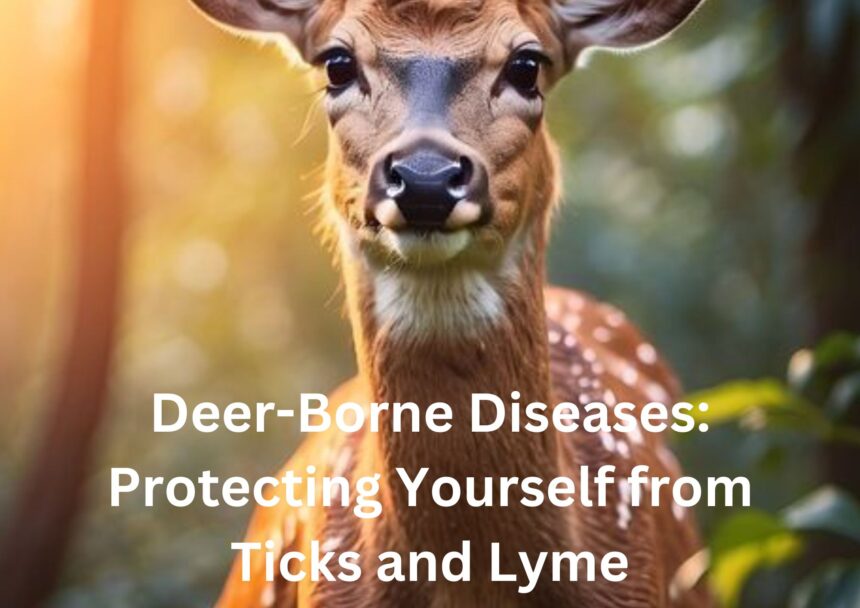Spending time outdoors is great for physical and mental well-being, but it also comes with certain risks especially when it comes to tick-borne illnesses.
In many areas, the presence of deer plays a significant role in sustaining and spreading tick populations, increasing the risk of diseases like Lyme disease, anaplasmosis, and babesiosis.
Understanding how these diseases spread and how to protect yourself is essential for staying safe while enjoying nature.
Understanding Deer’s Role in Disease Transmission
Deer are not the direct cause of tick-borne diseases, but they serve as crucial hosts in the tick life cycle. By supporting tick populations, deer indirectly contribute to the spread of diseases to humans and other animals.
Deer as Hosts for Ticks
Ticks go through multiple life stages, larva, nymph, and adult requiring blood meals at each stage to mature and reproduce. While they feed on various animals throughout their life cycle, adult ticks frequently use deer as hosts.
After feeding and mating on deer, female ticks drop off and lay thousands of eggs, significantly increasing the local tick population. Without deer, tick numbers would be much lower, reducing the chances of human infection.
The Connection Between Deer Population and Tick Abundance
The relationship between deer populations and tick abundance is clear: more deer lead to more ticks. As deer populations grow, so does the risk of encountering infected ticks. Areas with high deer densities tend to have greater incidences of Lyme disease and other tick-borne illnesses.
Effective deer population management strategies, such as controlled hunting and habitat modification, can help keep tick populations in check and reduce the spread of disease.
Geographical Distribution of Deer and Disease Risk
Regions with large deer populations and suitable tick habitats tend to have higher rates of tick-borne diseases.
The northeastern and upper midwestern United States, including states like Pennsylvania, Wisconsin, and Minnesota, are among the most affected areas. People living in or traveling to these high-risk zones should take extra precautions to prevent tick bites.
Major Deer-Borne Diseases: Identification and Symptoms
Ticks transmit several dangerous diseases, with Lyme disease being the most well-known. Others, such as anaplasmosis and babesiosis, also pose serious health risks. Recognizing their symptoms early can lead to faster treatment and better outcomes.
Lyme Disease: Symptoms, Diagnosis, and Treatment
Lyme disease often begins with a characteristic bull’s-eye rash around the bite site. Early symptoms can resemble the flu, including fever, fatigue, and muscle aches. If untreated, Lyme disease can cause severe complications such as joint pain, neurological issues, and heart problems.
Diagnosis is typically confirmed through blood tests, and treatment with antibiotics is most effective when started early.
Anaplasmosis and Ehrlichiosis: Similar but Distinct
Both anaplasmosis and ehrlichiosis present with fever, chills, headache, and muscle aches. Because their symptoms overlap, they can be difficult to distinguish.
These bacterial infections are treated with antibiotics, and early treatment is crucial to prevent severe complications.
Babesiosis: A Parasitic Threat
Unlike bacterial infections, babesiosis is caused by parasites that infect red blood cells. Symptoms include fever, chills, fatigue, and anemia.
While some cases are mild, people with weakened immune systems can experience severe illness. Treatment involves specific medications to target the parasites.
Identifying and Removing Ticks Safely
Preventing disease starts with recognizing and properly removing ticks. Learning to identify different types of ticks and their life stages can help you take action before they have a chance to transmit infections.
Tick Identification: Different Types and Stages
The black-legged tick (also called the deer tick) is the primary carrier of Lyme disease. Other ticks, like the American dog tick, are larger and less likely to spread Lyme but can transmit other diseases.
Ticks progress through larval, nymph, and adult stages, with nymphs being the most dangerous due to their small size and tendency to go unnoticed.
Prevention Strategies: Protecting Yourself and Your Family
Preventing tick bites is the best defense against tick-borne diseases. Simple precautions can significantly reduce your risk.
Personal Protective Measures: Clothing, Repellents, and Gear
- Wear long sleeves and pants in wooded or grassy areas.
- Tuck pants into socks to create a barrier against ticks.
- Use insect repellent containing DEET or picaridin.
- Treat clothing and gear with permethrin to kill ticks on contact.
- Conduct thorough tick checks after spending time outdoors.
Yard and Home Protection: Reducing Tick Habitats
Creating a tick-free environment around your home can lower the risk of tick encounters.
- Keep lawns mowed and remove leaf litter and brush.
- Place wood chips or gravel between your yard and wooded areas to deter ticks.
- Consider using tick control treatments in your yard during peak seasons.
Protecting Pets from Ticks and Deer-Borne Diseases
Pets can bring ticks indoors, increasing your exposure to tick-borne diseases. Use veterinarian-approved tick prevention products, including topical treatments, oral medications, and tick collars. Check pets for ticks regularly, especially after outdoor activities.
Long-Term Effects and Chronic Lyme Disease: Separating Fact from Fiction
Some individuals report persistent symptoms after Lyme disease treatment, sometimes referred to as “chronic Lyme disease.” The medical community debates this condition, with limited evidence supporting long-term antibiotic use. If you experience lingering symptoms, consult a doctor about symptom management.
The Role of Vaccines in Preventing Deer-Borne Diseases
A Lyme disease vaccine was once available but was discontinued due to low demand. However, new vaccines are currently in development, offering hope for more effective protection against Lyme and other tick-borne diseases in the future.
Conclusion
Deer contribute to the spread of tick-borne diseases by supporting large tick populations. Understanding the risks and taking preventive measures such as wearing protective clothing, using insect repellents, and conducting regular tick checks can help keep you and your family safe.
Early detection and prompt treatment are essential for preventing serious health complications. Stay informed, take precautions, and enjoy the outdoors safely.








